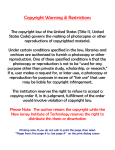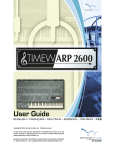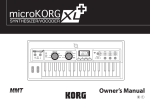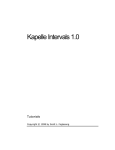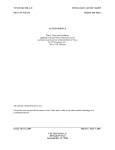Download Oberheim Two-Voice Instruction Manual & SEM 1A
Transcript
Oberheim Two-Voice Instruction Manual & SEM 1A Schematics instruction manual prepared by James Michmerhuizen cover design & conceptional layout by bluesynths.com A BRIEF INSTRUCTION MANUAL for the OBERHEIM TWO-VOICE SYNTHESIZER prepared by james michmerhuizen director, the boston school of electronic music GETTING FAMILIAR WITH THE OBERHEIM TWO-VOICE SYNTHESIZER 1: The POWER SWITCH is at the top left of the cabinet. 2: The 2ND-VOICE SWITCH is at the left of the keyboard. When the switch is off, voice module two will be gated when any one key is pressed on the keyboard (but see also the description of the VOLTAGE ASSIGNMENT SWTTCHES in the mini-sequencer); when the switch is on, voice module two will not be gated until a second key is depressed. 3: The PORTAMENTO control, normally left fully counterclockwise, introduces a lengthening pitch slide between different notes on the keyboard as it is rotated to the right. 4: The TRANSPOSE control switches the keyboard voltage one volt at a time through a range of three volts, resulting in oneoctave transpositions of the two VCO's. 5: The PITCH BEND control, normally centered, bends the keyboard voltage up or down as it is rotated, producing a corresponding pitch bend from the two oscillators. 1 The MINI-SEQUENCER is described separately on a following page. So are the VOICE MODULES; the controls of each module are identical to those of the other, the only difference between them being in the way they are controlled by the keyboard and sequencer modules. The OUTPUT MIXER consists of only three rotary pots and two phone jacks. The Jack connections are shown in the diagram, and the pots are: 6: the OUTPUT LEVEL CONTROL for voice module one, 7: the OUTPUT LEVEL CONTROL for voice module two, and 8: the MASTER OUTPUT CONTROL for the synthesizer. SETTING THE STAGE Before connecting your Oberheim synthesizer to headphones or to an amplifier, be sure that the master output control is fully off (counterclockwise). After making the external connection to headphones or amplifier, you may turn the synthesizer on. Locate the ASSIGNMENTS switches in the minisequencer section, and be sure that they are all down. In each voice module, set the controls to the positions shown on the following page by the asterisks; where there is no asterisk use the position in the photograph itself. You may now turn, if you want to, directly to the section called "FIRST STEPS" and begin to explore the synthesizer. But it would probably be better to spend just a few minutes reading through the descriptions of the minisequencer and the voice modules first. On the other hand, it would be a mistake to try to memorize in detail everything in the descriptions following; they contain some important facts--usually in italics--and some less important but still useful information. Some of this will become familiar to you simply from habit as you work with the synthesizer. 2 THE MINI-SEQUENCER AND SAMPLE/HOLD. 1. The CONTROL VOLTAGE PRESETS determine two different output voltages at each of the sequencer's eight positions. Each numbered position in this section of the panel has two independent concentric rotary pots. The outside pot controls the SEQUENCE OUTPUT ONE, and the inner pot determines SEQUENCE OUTPUT TWO. An LED at each position is illuminated when that position is active. 2. The VOLTAGE ASSIGNMENT SWITCHES determine the source and destination of voltages from the sequencer and sample/hold. In the module illustrated there are four switches. In the module included with the 2-voice synthesizer there are three switches; the description following applies to the three-switch version. The first switch on the left selects the source of control voltages and gates for VOICE MODULE ONE. In its lowest position, voice module one will be controlled by the keyboard only, and will not be affected by either the sequencer output voltages or the sample/hold output voltages. In the center position of this switch, voice module one will be gated by the CLOCK (#5 below) and its VCO's will be controlled by the output of the SAMPLE/HOLD (#4 below). When the switch is in its highest position, voice module one will be gated by the CLOCK and its VCO's will be controlled by SEQUENCE OUTPUT ONE. The second switch performs the same selecting function for VOICE MODULE TWO, except that in its uppermost position the VCO's in voice module two will be controlled by SEQUENCE OUTPUT TWO rather than sequence output one. 3 The third switch allows either KEYBOARD VOLTAGE ONE or KEYBOARD VOLTAGE TWO to be added, respectively, to either SEQUENCE OUTPUT ONE or SEQUENCER OUTPUT TWO. Thus one of the keyboard voltage outputs may be used to transpose a sequence from one note to another without affecting the pitches produced by the other voltage in controlling the other voice module. 3. The SEQUENCE LENGTH switch is used to shorten a full eightstep sequence down to anywhere from seven steps to only one. When this switch, for example, is set to "7", the sequencer will count through positions 1-7 and then skip the 8th step, starting over instead from position 1. This is useful in setting odd or asymmetrical rhythms. 4. The two rotary pots in this section of the panel determine respectively the RANGE covered by the sample/hold output voltage, and the amount of LAG (low-frequency filtering) applied to the sample/hold voltage. Turning the lag control to the right produces, in other words, the same effect on pitches being governed by the sample/hold, that the PORTAMENTO control produces on pitches being governed by the keyboard. 5. This is the MASTER CLOCK that steps the sequencer and operates the sample/hold. The rotary knob determines the frequency of this clock--i.e. the stepping rate or tempo. The three-position switch turns the clock on and off; it can also be clicked momentarily down to advance the sequencer one step or to cause a new sample voltage to be taken. A switch is incorporated into the clock tempo control, allowing the knob to be pulled out from the panel. In this position, the clock rate will be controlled by SEQUENCER OUTPUT TWO. This voltage control of the clock frequency is also affected by the third VOLTAGE ASSIGNMENT SWITCH: in its uppermost position (#2 above), the keyboard voltage is added to sequencer output two and will therefore also determine the clock rate. 4 THE VOICE MODULES The panel controls on each module are identical. In the diagram above they are grouped by similar functions for easy understanding. The asterisks in sections la, 2a, 3, 4, 7, 8, and 10 are for use in the following section of the manual. la, 2a. These are the MANUAL TUNING CONTROLS for VCO 1 and VCO 2 respectively. The lower flanged portion of each knob is for coarse tuning, and the upper part of the knob is a vernier fine tuner. lb, 2b. The three-position switch selects one of three control signals, indicated on the panel, to be routed through the rotary pot just above the switch. If this knob is rotated to the right, the selected control voltage will affect the VCO pulse width. If this knob is rotated to the left, the selected control voltage will affect the VCO frequency. If the knob is left in its vertical position (as in the photograph), the selected control voltage will have no effect on the VCO at all. 1c, 2c. These are MANUAL PULSE WIDTH CONTROLS for the two oscillators. At vertical, as in the diagram, the pulse produced in each cycle is exactly one-half as long as the cycle itself; 5 such a signal is called a square wave. As the knob is rotated in either direction from vertical, the pulse becomes wider (to the right) or narrower (left). 3. When this switch is NIZED to the frequency switch regardless; but produce only harmonics When the switch is off pendent. moved to the right, VCO 2 is SYNCHROof VCO 1. VCO 1 is not affected by this VCO 2, when it is "sync'd" to VCO 1, can of the frequency to which VCO 1 is set. the two oscillators are completely inde- 4. These are the three MANUAL CONTROLS for the filter. The smaller knob at the lower right determines whether the filter will act as a bandpass filter (at the click-stop position labelled "BP"), lowpass filter (immediately clockwise from the click-stop, labelled "LP"), notch filter (vertical, at the word "notch"), or highpass filter (extreme clockwise, labelled "HP"). Do not try to turn the knob clockwise past the highpass stop. The large vernier control at the upper left determines the frequency at which the filter begins to take effect, or the center frequency of the bandpass and notch modes. In the low- and high- pass modes the frequency at which the filter begins to have some effect on a signal passing through it is called the cutoff frequency of the filter. The large single knob labelled RESONANCE determines the filter resonance at its cutoff frequency. When this knob is fully counterclockwise the filter resonance is at a minimum; as it is rotated to the right the resonance increases. RESONANCE is a term for the gain (i.e. roughly, loudness) of the filter at or near its cutoff frequency. At maximum resonance, for example, the filter amplifies strongly any components of the input signal that lie within a semitone or so of the cutoff frequency, but virtually ignores components that are not near the cutoff frequency. In other words, a pronounced "peak" occurs in the filter frequency response as the resonance is increased, which grows higher in amplitude as it grows narrower in width. When the center of this peak is exactly at the frequency of an audio input to the filter, a relatively weak signal can drive the filter to produce a quite strong output. 5. The switch selects one of three sources for a control input to the filter. The left and right positions are self-explanatory; the center position carries a signal from the SAMPLE/HOLD section of the mini-sequencer panel. This signal is independent of any of the routing and assignment switches in the 6 mini-sequencer. The knob is a "reversible attenuator" for the control signal selected; in the photographed position, no signal will pass through to have any effect on the VCF CUTOFF FREQUENCY. As the knob is rotated to the right, the selected control signal affects the VCF directly; as the knob is rotated to the left, the signal affects the VCF inversely, i.e. a positive voltage drives the VCF frequency down rather than up. 6. These are the AUDIO INPUT SELECTOR/ATTENUATORS for the VCF. In the photographed position, they are all OFF. Unless at least one of these is "open", i.e. rotated either to left or to right, the module will produce no sound regardless of any of the other settings anywhere on the module panel. The first knob on the left, labelled "VCO 1", selects either the sawtooth (leftwards) or pulse (rightwards) signal from VCO 1 as an audio input to the VCF. The second one does the same for signals from VCO 2. The left side of the third knob is not connected to any signal (except that for the first VOICE MODULE there is a Jack at the back of the synthesizer for an external audio signal input, and this jack is wired to the left position of the knob on module one); the right side is wired directly to the output of the NOISE GENERATOR that is part of the sample/ hold in the minisequencer. Noise, filtered in various ways, is used in the production of wind, thunder, and motor sounds, as well as many percussion effects. Signals from the two oscillators and the noise generator may be mixed in various proportions by opening all three of the input attenuators at the same time. 7. These three rotary pots determine the behavior of ENVELOPE GENERATOR ONE. The first two knobs set two time constants: the attack time constant is the amount of time required for the ENV 1 OUTPUT VOLTAGE to rise from 0 to maximum, and the decay time constant is the amount of time required for the ENV 1 OUTPUT VOLTAGE to fall... ...from maximum to the level set by the third knob, and ...from this sustain level back to 0. The third knob determines, not a time constant, but a voltage constant. This constant is the level at which the ENV I output will be sustained (hence the label) for as long as a GATE signal is present at the gate input of the envelope generator. GATE signals may originate either from the keyboard or from the MASTER CLOCK in the minisequencer. They act as "begin-end" instructions to the envelope generators; on the appearance of a gate signal at its input, an envelope generator commences an ATTACK-DECAY-SUSTAIN---cycle, and when the gate signal ends, the envelope generator executes a final DECAY as described 7 above. Gates are thus members of the general class of TIMING signals; other timing signals are TRIGGERS. The Oberheim 2-voice synthesizer does not use trigger signals. 8. These three knobs set the constants attack time, decay time, and sustain voltage level for ENV 2. NOTE: as you can determine by examining the control voltage select switches for the two VCO's and the VCF, ENV I can be used to control VC0 1, and ENV 2 can be used to control VCO 2 andlor the VCF. in ordinary keyboard use, i.e. without special effects, ENV I will be used only to control the VCA, and ENV 2 will be used only to control the VCF. 9. Each voice module contains a LOW-FREQUENCY OSCILLATOR. The output of this oscillator is a sine wave and is available to control the VCO's and/or the VCF through the voltage select switches described under #lb, 2b, and 5. The actual frequency of the LFO is set by the knob indicated here. 10. Normally the VCA is controlled by ENV 1 (see NOTE above). In order to simplify the operation of the voice module while learning, or whenever it is necessary to hear continuous sound, this VCA BYPASS SWITCH can be moved to the on (right) position. This disconnects ENV 1 from the VCA control input and leaves the VCA permanently wide open so that signals pass through it completely unaffected; in effect, the VCA is "bypassed." Moving the switch to the left closes the VCA again and reinstates the control voltage from ENV 1. 11. This light indicates the presence of a GATE signal (see #7 above) at the input to the two ENVELOPE GENERATORS. Press a key; depending on the position of the 2ND-VOICE switch at the left of the keyboard, one or both of the indicator lights will go on. NOTE: Even before hearing any sound from the synthesizer, you can use these indicator lights to understand the function of the VOLTAGE ASSIGNMENT SWITCHES (minisequencer #2). Move the two left switches up to the SIH position, and press a key or two; note that the lights do not now go on. Start the CLOCK (minisequencer #5) and note that they go on and off regularly at a rate that increases as the clock frequency increases. 8 FIRST STEPS A. CONTINUOUS SOUND Begin by setting all the controls on VOICE MODULE ONE to the positions indicated in the diagram/photograph on page five, except for #1a, 2a, 3, 4, 7, 8, and 10, which should be set to the positions indicated by the asterisks. Open the MASTER OUTPUT LEVEL control to about two-thirds. Open the OUTPUT LEVEL CONTROL for voice module one about two-thirds. Now opening any one or more of the AUDIO INPUT SELECTORS (#6) in voice module one will allow you to hear a signal from the corresponding signal source. Listen to each of the VCO signals, and to the noise generator (the third knob, rotated clockwise from center, brings in the noise generator). Experiment with various tunings of the two oscillators relative to each other; with the keyboard and its controls; with the manual pulse-width controls of each oscillator (note that these have no effect on the sawtooth oscillator outputs); and finally with the VCF manual controls for frequency, resonance, and pass mode. Do not at this time experiment with the controls numbered lb, 2b, or 5. NOTE: You should pay particularly careful attention to the way the three VCF manual controls interact with each other. For examples---IF the frequency setting is low (left) and --IF the mode is lowpass (LP), THEN no signal will pass through the VCF even when all audio inputs are open. Conversely, -- IF the frequency setting is high, and -- IF the mode is highpass (HP), THEN you will hear nothing, or very little, even though all the audio inputs are open. B. VOLTAGE CONTROL OF THE OSCILLATORS AND THE VCF Listening only to the pulse output of VCO 1, and with the filter settings as given on page five, examine the switch and knob in section lb of the panel. As long as the knob is centered vertically, the position of the switch makes no difference. 9 Now move the switch to the right. This selects, as a control signal, the output of the LFO. Rotate the knob to the left; you will hear the pitch rise and fall, further in each direction as the knob is rotated further to the left. The rate (i.e. speed or frequency) of this rise and fall is directly determined by the frequency of the LFO itself; and you can change that with the knob #9 in the diagram. After you have experimented with this for a while, return the controls to the settings of page five. Now open the input from the noise generator; switch the VCF to bandpass operation; set the resonance about one-third; and raise the frequency of the VCF to about 1 o'clock position. You should hear something like whistling wind. The control voltage selector and attenuator for the VCF are in section #5. Move the switch to the right, and the attenuator to either right or left. The approximate "pitch" of the whistling wind will rise and fall under control of the LFO. NOTE: The VCF cannot generate signals of its own. It can only change the balance of different frequency components present in the audio signal given to it. When you change the VCF "frequency" setting, either manually or by voltage control, you are changing the "range" or "area" of particular frequencies that are emphasized. Try using maximum resonance with a lowpitched sawtooth input open only a little--about 10 o'clock--and manually sweeping the VCF frequency from bottom to top slowly. You should be able to hear individual harmonics of the sawtooth very easily. Return to the "whistling wind" setup for the next step. Now move the control selector switch to the left, providing ENV 2 as the control signal, and rotate the signal attenuator to the right about halfway open (3 o'clock'position). Depress any key on the keyboard, and hold it down. You will hear the area of emphasized frequencies in the noise--the "whistling"--rise and fall again. Continue these experiments with different settings of the ENV 2 attack, decay, and sustain constants, until you are thoroughly familiar with them. Then leave the settings unchanged at the positions of the diagram on page five, while you press a key repeatedly; each time lowering the VCF frequency setting a little, and increasing the control signal amplitude by rotating the knob a little further to the right. Now try an oscillator signal instead of the noise generator input signal. Drop the resonance to minimum and use the lowpass mode. The settings you have now arrived it provide one way of interrupting the continuous sounds you have been hearing up to 10 now, so that the synthesizer "produces" a sound only when you have pressed a key. Experiment with various settings of the ENV 2 controls, and with setting various relationships between the VCF frequency control and the knob (#5) that determines control signal amplitude. NOTE: These relationships are the most crucial ones in the synthesizer; until they are mastered, you will not be getting the most that you can from your instrument. A quick summary of the most important points to learn: (verify each one as you read.) a) in many keyboard setups the filter is either closed, to open only under control of ENV 2, or (less often) open, to be closed only under control of ENV 2. b) a highpass filter is closed when its frequency is high; a lowpass filter is closed when its frequency is low; a bandpass filter is closed when its frequency is either high or low; and a notch filter is always open. c) when the control input attenuator is rotated left, the incoming signal from ENV 2 drives the filter frequency down; as it is rotated to the right, the ENV 2 signal drives the filter frequency up. d) as the filter resonance is increased, its output level will--generally--increase. Compensate by lowering slightly the level of the input audio level. At maximum resonance a very small input signal is enough to produce full output from the filter (in a very narrow band of frequencies). C. INTERRUPTED SOUND If the filter manual frequency setting is at minimum, and the mode control is set for lowpass operation, and the control input attenuator is at maximum right, the filter alone will be capable of producing "events" under keyboard control. In other words, with these settings you will hear nothing until a key is depressed, thus gating the ENV 2 "on" which opens the filter to allow a signal to pass through. In many cases, however, you will want to use the filter for some other purpose--perhaps controlled by the LFO, or even not controlled at all except manually. Good oboe and bassoon timbres, for example, require a resonant filter at a constant frequency. In all of these cases, you will need to use the VCA to interrupt the continuous source sound and produce "events." 11 To make a simple beginning at this, return the filter settings to the positions of page five, and open the audio input from the noise generator. Then move the switch #10 to the left. The VCA is now under the control of ENV 1, and will allow signals to pass through only when ENV 1 is gated on. Press a key and hold it until the resulting event is over. Change the settings on ENV I and do it again; continue to experiment until you can anticipate the kind of event that will result from any arbitrary setting of the ENV 1 constants. You can gate ENV 1 automatically--instead of from the keyboard--by moving the left assignments switch in the mini-sequencer to either its middle or upper position, and turning the CLOCK on. Do this now, and set the CLOCK tempo to something near one beat (gate) per second. Events are now produced automatically, leaving both your hands free to manipulate the VCF manual controls. For an example of a practical application, reduce the noise input to about two o'clock, set the filter resonance to maximum, and the filter mode to bandpass. The ENV 1 should be set for minimum attack and sustain and fairly short decay. Now slight changes in the filter frequency control in the range 12 o'clock to 3 O'clock will produce a wide range of percussive noises. In a later section you will learn that even these changes in the filter frequency need not be done by hand, but can be programed from the s/h unit. D. TWO VOICES AND THE KEYBOARD You are now acquainted with all the controls that determine the character of individual events from the synthesizer. All of the remaining controls are used for producing chains of events--i.e. melodies, repeating sequences, bass lines, random percussive rhythms, etc. But up to this point you have used only VOICE MODULE ONE, under the control of KEYBOARD VOLTAGE ONE. You are now ready to use the second voice module; do so by opening the OUTPUT LEVEL CONTROL in the output mixer, and moving the 2ND VOICE switch at the left of the keyboard to ON. Set the controls on the second voice module to any of the useful patches you have already found, and use the keyboard to play both modules simultaneously. You should be able to verify the following "keyboard logic": a) VOICE MODULE ONE always follows the pitch represented by the leftmost key depressed. VOICE MODULE TWO always follows the rightmost key depressed. If three keys are depressed, the middle key has no effect. 12 b) If only one key is depressed, only voice module one will be gated; if, while one key is held down, another is depressed to the right of the one that is being held down, voice module two will be gated on with the new note; if, on the other hand, another key is depressed to the left of the key already being held down, then voice module one will be assigned to the lower key--thus moving to a new pitch-and voice module two will be given the upper key; both voices will be gated simultaneously. c) Legato playing on the second voice will not produce new pitches unless the 2ND VOICE switch is OFF. Legato playing on the first voice will produce new pitches regardless. d) The PORTAMENTO and PITCH BEND controls do not affect both keyboard voltages in the same way, and exactly what they do to the second voltage depends on the position of the 2ND VOICE switch. NOTE: a vast number of special effects are possible with various configurations of the keyboard controls. The most ordinary and conservative results, however, will come from playing continuous legato on the lower voice, and a slight nonlegato on the upper voice. E. TROUBLESHOOTING (I) Using only the controls we have introduced so far, it is--as you have probably discovered already--possible to reach situations in which you are momentarily lost, either because you are not getting any sound at all when you press a key, or because you can't seem to make the sound shut off even when no key is depressed. The following checklist will review the things to look for in both cases. 1. NO SOUND: (EITHER MODULE) - is the master output level open wide enough? - is the output level control for the module open? - is at least one of the module audio inputs open? (See p. five and the description of area 6 in the diagram.) - is the filter open? (See the definitions of "open" on p. 11, and the note in italics on p. 9.) - if the filter is closed, is the setup of the switch and attenuator #5 such as to open it with an envelope? - certain envelope settings of the two generators will interact to prevent an audible output from leaving a module; for example, a short attack and decay on ENV 1, min. sustain (controlling the VCA) with a long 13 - - - attack on ENV 2 controlling the filter from a closed lowpass configuration: the VCA will be open-and-closed again before any significant output is developed from the filter. are the oscillators tuned higher than audibility? is the proper assignment switch--in the mini-sequencer--set to keyboard control of the module? if the assignment switch is not set to keyboard control, is the clock on or off? (No gates can be produced, of course, unless the clock is on.) how high is the sustain level on ENV 1? In legato keyboard playing, when the VCA is under control of ENV 1, there must be some sustain voltage or the output of the module will disappear more or less rapidly, depending on the decay time setting of ENV 1. The same holds for the filter when its manual setting is closed and only ENV 2 opens it. 2. CONTINUOUS SOUND: (EITHER MODULE) - there are really only two ways to get continuous sound from a module; one of them you are already familiar with since that's how we started you off: the VCA BYPASS switch on, and the filter open. If either of these conditions does not hold then no continuous sound is possible, except that - with certain envelope settings, under gating from the clock, an extremely high tempo setting of the clock control will produce virtually continuous sound simply because of the high tempo. (Imagine playing notes on a piano as rapidly as possible, like a mandolin-"continuous sound".) Naturally this can't happen unless the proper assignment switch on the minisequencer is set for gating from the clock rather than the keyboard. F. USING THE MINISEQUENCER As you already know, the ASSIGNMENTS switches in the minisequencer section of your Oberheim synthesizer must be down in order to play the voice modules from the keyboard. In the down position, each module gets a keyboard control voltage, which controls the oscillator pitches, and a keyboard gate signal, which starts and stops the envelope generators. If the assignment switch for either voice module is in either the middle or upper position, both the keyboard control voltage and the keyboard gate signal are disconnected from the module 14 and can have no effect on its behavior. Instead, the envelope generators for the module will get their gate signals from the CLOCK in the minisequencer--you already are familiar with this from paragraph two on page twelve--and the oscillators will get their control voltages from either the S/H unit or from the 8-step sequencer, depending on the center or upper position of the assignment switch. Now move the assignment switch for voice module one to its upper position, labelled SEQ 1. Move the switch in the CLOCK section of the minisequencer to its upper position, labelled "run". The gate light in voice module one should immediately start blinking (more or less rapidly depending on the chance frequency setting of the CLOCK), and a series of events of different pitches should be produced from voice module one. If you hear nothing, see the preceding section E.1 of this manual. Note that at each new pitch, a new position light illuminates on the minisequencer. In order to change the pitch produced at any particular step, stop the clock on that particular step and open the signal path so as to get continuous sound. Then use the CONTROL VOLTAGE PRESET at that position to change the pitch of the oscillator. The on-off switch for the minisequencer CLOCK has also a lower position labelled step. This position is spring-loaded and the svitcb will not stay there; but every time you push it down, the sequencer will advance to the next step in the sequence. This enables you to set an entire 8-step sequence rapidly and easily. When you have set up a sequence that you like, try playing voice module two from the keyboard along with you sequence. NOTE: if you find that you can't get any sound out of the second voice, check the 2ND VOICE switch At the left of the keyboard. It should be OFF. (If it is ON, you will have to press two keys in order to get a gate for the second voice--remember?) Now voice module two will be controlled by the sequencer if the second ASSIGNMM switch is set to the SEQ 2 position. A second set of control voltages is available from the sequencer CONTROL VOLTAGE PRESETS, so that the pitches produced by the second voice can be set independently of those produced by the first voice; the inner knob at each sequencer position determines the SEQ 2 voltages. NOTE: Many beginners find some difficulty in tuning to familiar pitches and intervals because of the continuously variable tuning controls. At the end of this manual, under the heading "PERFORMING HINTS," we will give some simple aids to tuning under various circumstances. 15 Through all of your experiments so far with the minisequencer, the third ASSIGNMENTS switch should have been down. Now move it to its center position, labelled SEQ 1 By CV 1. In this position, KEYBOARD CONTROL VOLTAGE #1 is reintroduced to the control inputs of the VCO's in voice module one. Try it; you will find that the keyboard can now TRANSPOSE any sequence being produced by voice module one. All of the keyboard controls themselves--portamento, pitch bend, the transpose switch--are effective. If both modules are under sequencer control, you will find that the pitches produced from the second voice module are, however, not affected by the keyboard. It should not be hard to guess that in the SEQ 2 BY CV 2 position, the sequencer output voltage to the second voice module will be transposed by KEYBOARD CONTROL VOLTAGE #2. The first voice will not be affected by anything you do at the keyboard. Since, however, the 2ND VOICE switch plays a role in determining when and how a second control voltage is produced from the keyboard, it will also affect the transpositions of SEQ 2. For example-a) if the switch is off, transpositions will occur with the depression of only a single key; if one key is held down while another is depressed to the right of it, the sequence will transpose to the higher key only for as long as the higher key is depressed. When the key is released the sequence will transpose down again to the pitch of the lower depressed key. b) If the switch is on, one-key-at-a-time playing will not transpose the sequence; but if one key is held down, and another is pressed to the right of it, the sequence will transpose and will hold the transposition after the second key is lifted. No further transposition will occur until the next occasion on which two keys are depressed. NOTE: The latter setup gives you considerable performing freedom in controlling voice one from the keyboard. A sequence transposition can be established for voice two by pressing two keys; after that you have the full freedom of the keyboard for playing voice one. But you must develop a non-legato touch; any overlapping of keys will be interpreted INSTANTLY by the keyboard electronics as a transpose instruction for the second voice sequence. This use of a non-legato playing technique does not mean, of course, that you cannot have legato phrasing; that will be determined by the decay time on your envelope generators, not by your keyboard touch. 16 Finally, you should experiment with the control of the CLOCK itself by SEQ 2. This is accomplished, as the panel indicates, by pulling the clock frequency control knob out from the panel about a quarter-inch. Do that; notice that the stepping rate suddenly becomes irregular, but forms repeating patterns every eight steps. Now the length of any one step will be determined by the SEQ 2 CONTROL VOLTAGE PRESET for that step. Use the presets to set up a regular rhythm; the clock frequency control will determine the overall tempo. NOTE: Since, when the SEQUENCER TRANSPOSE switch is at the SEQ 2 BY CV 2 position, the keyboard second control voltage is added to the voltage output of SEQ 2, then when the CLOCK frequency is being controlled by SEQ 2, the frequency will also be determined by the keyboard. IN OTHER WORDS, this setting gives you keyboard control of a sequencer tempo! G. THE SAMPLE AND HOLD UNIT The control voltages produced by SEQ 1 and SEQ 2 are programmed at each step by the performer. Voltages from the SAMPLE/HOLD unit are random. Listen to voice one under control of the s/h; begin with the two knobs in the s/h section rotated maximum counterclockvise, and slowly increase the range setting. The first voice produces a series of random pitches over a wider and wider range as the knob is rotated further to the right. The lag knob introduces a portamento into the pitch changes--longer as it is rotated to the right. Try it. The middle position of the VCF control selector, labelled "EXT", carries a 9/h voltage to control the filter. Try using a noise input to the filter, open only to about two o'clock, and set the filter to bandpass operation at maximum resonance. Use a short percussive envelope on the VCA and adjust the VCF frequency to about the middle of its range or a little higher. Open the control input attenuator on the filter while the s/h is running. You should hear a series of percussive events of various noise colors. Remember doing this by hand back at page twelve? You can introduce accents into the series by lengthening the decay time on the VCA envelope: try it. Make the patch more complex by setting up the keyboard-control-of-tempo effect you learned in the preceding section. H. PERFORMING HINTS You have now learned something about each of the functions in the Oberheim 2-voice synthesizer, and something of how each 17 control interacts with the others to produce a wide range of sounds. Continuing practice will make you fluent in moving from one sound to another quickly and accurately. In the meantime, here are some hints to help you achieve this sooner. TUNING AIDS 1. In tuning the oscillators, it helps to leave the VCF and VCA open--that way you don't have to keep striking a key as if you were tuning a guitar or piano. 2. To tune a module to concert, or "standard" pitch, set the keyboard TRANSPOSE switch to 8' and depress the middle A while you tune one oscillator to your external pitch source. Then release the A. The second VCO can be tuned to the first; use sawtooth waves for all tuning procedures. 3. Tune only two oscillators at a time, using the same oscillator as your reference each time. For example, make VCO I in the first module your reference; then after you have tuned VCO 2, close the audio from VCO 2 and open VCO 1 in the second module and tune it, and finally close that input and open the one from VCO 2 in the second module and tune VCO 2. Then open all four to check. 4. The beat frequency will always double as you go up by octaves. So after you have tuned at 8', go up to 4' and then 2' to check on the tuning of each oscillator; readjust if necessary. If you ever find that an oscillator seems to go out of tune as you go down again, you may need to calibrate it. 5. It is generally useful to tune the two VCO's in a single module to some interval other than unison. Try octaves, twelfths, fifteenths, and other harmonic intervals within a three-octave range. Drop the level of the higher VCO when tuning; it will make the beats more audible. 6. You needn't attempt to get the beat frequency actually down to ZERO. "Zero-beat" is an approximate phrase for anything less than one beat every second or two. In many cases you will actually want the slight "singing" quality produced by this slow beating--this is literally a phasing effect. (Use two sawtooth waves in unison and play them through short-decay percussive envelopes: listen to the color changes as the two signals go in and out of phase.) 7. SETTING PITCHES IN A SEQUENCE. Suppose that you want to set a pitch sequence for VOICE ONE under the control of SEQ 1. With both modules open, and assuming they have already been tuned to unison from the keyboard, switch 18 the first voice to SEQ 1 control and set the 2ND VOICE switch OFF. Play the first note of the sequence on the keyboard; it will be produced from the second voice module which is still under keyboard control. (If the sequencer is not at step one of the eight steps, use the manual STEP to get it there.) Use the control voltage preset to tune the first voice to unison with the pitch being produced from voice module two. Play the next note in the sequence, advance the sequence one step, and repeat the tuning procedure. Continue until the sequence is complete. RULES OF THUMB FOR FILTER CONTROL 1. Suppose that the VCF frequency is at maximum.. It would make little sense to open the control attenuator in the positive direction, since that could only increase the frequency even further, so... 2. Imagine that the frequency knob and the attenuator knob are geared together so that as one is turned to the left the other must turn to the right. This will keep your settings in the most effective range. 3. As you increase the filter resonance beyond about the eleven o'clock position, begin to decrease the audio input levels to the filter, until at maximum resonance the audio input level(s) is(are) no further than about ten o'clock or two o'clock position. GENERAL REMARKS 1. Remember that you do not always have to use the two voices separately. Complex and beautiful sounds can be produced in single-voice operation by combining the two modules, using complementary envelope settings on each one. For example, use a percussive envelope on one and a long-attack, "bowed" attack on the other. The two sounds will fade from one to the other. 2. You can also set them up as two contrasting voices and use the level controls on the output mixer to "switch" from one to the other. In other words, use them as "preset" voices. 3. For the most flexible, expressive playing, in every patch try to identify two or three points at which you can make significant performing changes in the sound with a minimum effort. For example, once you have a good "brass" envelope using a sawtooth wave, you will have a good clarinet for practical purposes simply by changing the input audio to a square wave. 19 SEM 1A Schematics Envelope Generators LFO VCOs VCF VCA NOTES POWER SUPPLY ONBOARD REGULATOR TRIMMER LOCATION WIRING HARNESS conceptional layout by bluesynths.com


































